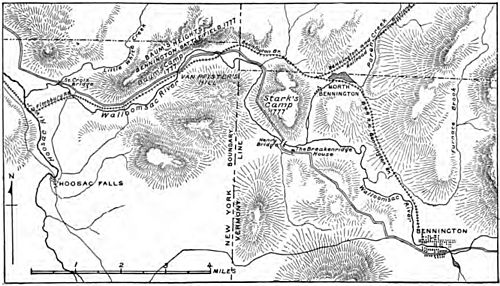Bennington Battlefield State Historic Site facts for kids
|
Bennington Battlefield
|
|

The Bennington Battlefield State Historic Site in Walloomsac, New York, where the Battle of Bennington occurred on 16 August 1777.
|
|
| Location | NY 67, Walloomsac, NY |
|---|---|
| Area | 1,250 acres (510 ha) |
| NRHP reference No. | 66000564 |
Quick facts for kids Significant dates |
|
| Added to NRHP | October 15, 1966 |
| Designated NHL | January 20, 1961 |
The Bennington Battlefield is a very important historical place in Rensselaer County, New York. It's where the famous Battle of Bennington happened on August 16, 1777, during the American Revolutionary War. This battlefield is located on New York State Route 67 in a town called Walloomsac, New York. This road was a key route between Bennington, Vermont and the Hudson River back then.
During the battle, soldiers from New Hampshire, Vermont, and Massachusetts – who were part of the American militia – fought against British forces. These American soldiers were led by General John Stark. They successfully stopped a British attempt to capture American supplies. Because of its historical importance, the Bennington Battlefield was named a National Historic Landmark in 1961. Today, part of this battlefield is protected as the Bennington Battlefield State Historic Site.
What is the Bennington Battlefield?
The main part of the Bennington Battlefield is about 2.5 miles (4 kilometers) west of the New York-Vermont border. It's on the north side of the Walloomsac River. The river valley here has many hills with steep sides. The state historic site includes the top of one of these hills and the land around it. This is where some of the fiercest fighting took place during the battle.
Today, the main road, Route 67, doesn't follow the exact path it did in 1777. However, a bridge on a nearby smaller road is thought to be close to an important river crossing from that time. Most of the hills are now covered with trees. Parts of the flat land near the river are still used for farming, just like they were in 1777. The top of the hill at the state historic site has been cleared of trees. A railroad track built in the 1800s also runs along the river, which has changed the look of the battlefield a bit.
The Battle of Bennington
Before the Battle of Bennington, British troops, mostly German soldiers called Hessians, were camped on top of this hill. They were led by Colonel Friedrich Baum. Other groups of British soldiers guarded a bridge, a ridge on the south side of the river, and a stream crossing to the north.
The American troops, led by General Stark, were very clever. They secretly explored the British positions and then launched a surprise attack. Colonel Baum's forces were eventually defeated, and he was killed. Even when more Hessian soldiers arrived later in the battle, they were also chased away. The fighting spread out for about a mile further down the river valley.
This battle was a big problem for British General John Burgoyne. He was trying to push his army toward Albany, New York. The Battle of Bennington cost him much-needed supplies and a large number of his soldiers. This loss weakened his army and helped set the stage for his surrender later at Saratoga. The American victory at Bennington was a key moment in the Saratoga campaign and helped turn the tide of the Revolutionary War.
-
A plaque erected by the state of New Hampshire commemorating the achievements of John Stark and the New Hampshire militia












